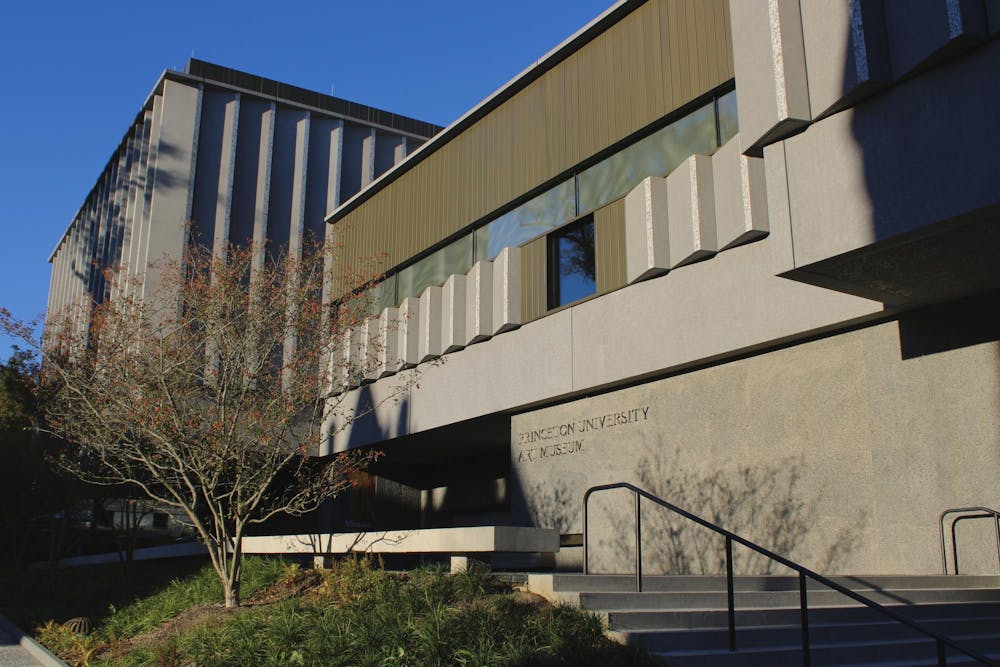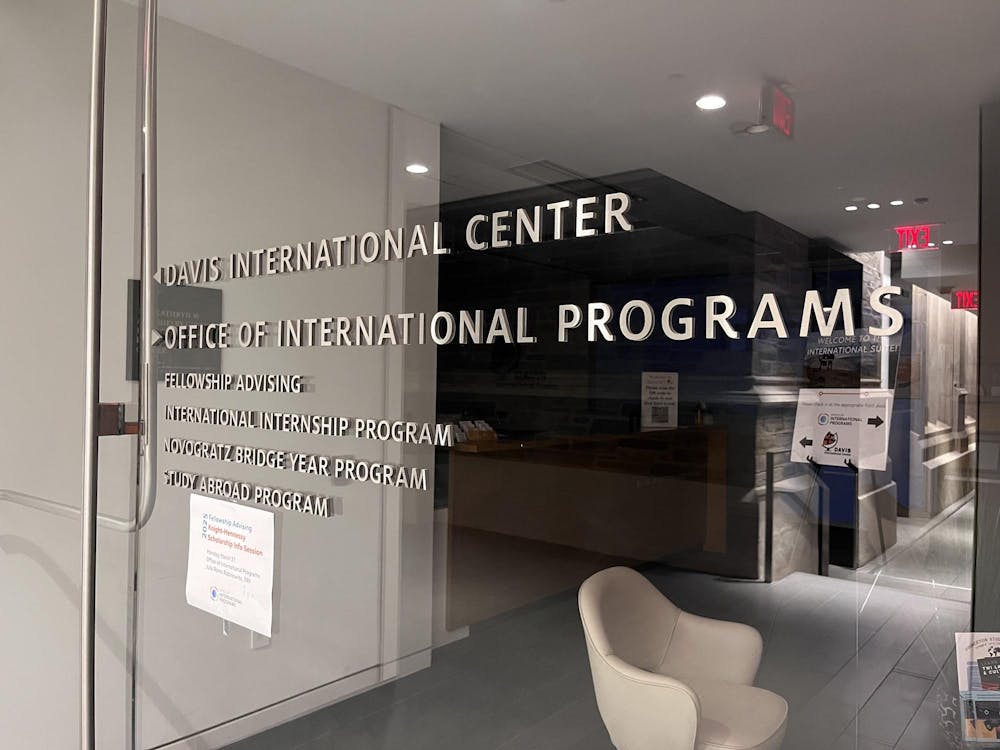In the Princeton University Art Museum’s maze-like galleries of eye-catching material, it can be hard to know what to look at first. While there are many paths, there are also highlights you won’t want to miss. If you’re planning a visit to the museum, but only have a short time to stop by or feel overwhelmed by the abundance, consider our recommendations for your itinerary.
“Water Lilies and Japanese Bridge” by Claude Monet — Emma Cinocca, Prospect Staff Writer

"Water Lilies and Japanese Bridge" by Claude Monet
Emma Cinocca / The Daily Princetonian
Inhabiting a wall of its own in the European Pavilion, Claude Monet’s “Water Lilies and Japanese Bridge” is both a classic and one of many — it is one in a series of about 250 oil paintings of water lilies by Monet. Princeton’s entry recalls similar pieces in the National Gallery of Art in DC, the National Gallery in London, and the Metropolitan Museum of Art in New York City.
In Princeton’s museum, the saturated blue pattern backing the painting’s ornate golden frame strongly contrasts the pastels of Monet’s impressionist water garden. The longer I looked, the more the contrast pulled me towards the painting. The pale greens and blues almost melt into the backdrop of willows. The colors — while muted — do not blend entirely. The painting’s overall atmosphere exudes quiet serenity. When viewing the piece, I was surrounded by a group of fellow captivated onlookers. “Water Lilies and Japanese Bridge” serves as a place of refuge. A moment of calm to slow down, reset, and start again.
Emma Cinocca is a member of the Class of 2027 and a staff writer for The Prospect. She can be reached at ec1078@princeton.edu.
“Notary” by Jean-Michel Basquiat — Amy Jeon, Prospect Contributing Writer

"Notary" by Jean-Michel Basquiat
Amy Jeon / The Daily Princetonian

Bold, electric, and delightfully hectic, Jean-Michel Basquiat’s “Notary” captures art as a commodity. The art seems set into motion, transforming into a bank note. In his scrawling artistic style, Basquiat weaves haphazardly placed words together under the theme of transaction. The word “PLUTO” is repeatedly crossed out and rewritten with a copyright symbol. Meanwhile, the words “LEECHES,” “FLEAS,” and “DEHYDRATED” are painted on the right side of the canvas — which implies that creating art under the pressure of art collectors can suck the creativity from the art-making process. A frenzied anatomical figure takes charge of the center of the canvas, while the phrase “study of the male torso” is written on the right — possibly an allusion to da Vinci’s anatomical drawings.
In “Notary,” Basquiat’s weaves seemingly disparate motifs, evocative phrases, and frenetic brushstrokes to create a thrillingly curious viewing experience. The piece’s combined elements have a striking freneticism as they trace the feverish movement of figures and subtle themes.
Amy Jeon is a contributing writer for The Prospect and a member of the Class of 2029. She can be reached at aj9410@princeton.edu.
“Torso of an emperor in armor, ca. 50-100 CE” — Mia Mazzeo, Contributing Prospect Writer


Despite being fragmented remains, this marble torso looms over the Ancient Mediterranean gallery. Immortalizing a now unidentifiable Roman emperor, the sculpture asserts its presence with its hulking size, intricate carvings, and fascinating history. The breastplate is adorned with the fatal head of Medusa, and the striking flourishes of the armor also demand attention. The winged Victories at the center of the torso erect a trophy by nailing non-Roman shields to a tree, a powerful symbol meant to legitimize the unknown emperor as a respected conqueror.
The sculpture, like many others in the gallery, would have once been painted with vibrant hues. Remnants of ancient restoration hint at the complex political backdrop surrounding the statue’s iterations. Having been knocked down and altered, the statue underwent a process known as Damnation Memoriae, the purging of all traces of an evil emperor after their reign.
Whatever emperor the torso belonged to, the magnitude of this figure are apparent with its elegance and detail.
Mia Mazzeo is a contributing writer for The Prospect and is a member of the Class of 2029. She can be reached at mm4755@princeton.edu.
“The Center of Creation (Michael)” by Mario Moore — Lily Hutcheson, Prospect Assistant Editor

"The Center of Creation" by Mario Moore
Lily Hutcheson / The Daily Princetonian
The museum’s second-floor orientation gallery is a hodgepodge of some of its most impressive and arresting works, each one vying for patrons’ attention. However, “The Center of Creation (Michael)” by Mario Moore stands out for its stature and contrast to other oil portraits nearby. The painting was created during Moore’s 2018-19 Hodder Fellowship at Princeton, during which he produced portraits of numerous Black staff members on campus. Here, Moore’s painting portrays security guard Michael Moore — no relation to the artist — who was employed at the art museum itself before its revamp. He holds the elevator door open to reveal the Kienbusch Galleries of the old museum building, now reimagined as an exhibition of Black artists, including Charles White and Barkley Hendricks. The portrait captures the softened realism of an excellent oil painting, and its sharp details give the sense of its subject’s fully fleshed-out life.
Among a globe-spanning lineup of household names and artworks, “The Center of Creation” provides an opportunity for patrons to connect with the museum’s local and historical context. According to the corresponding wall plaque, the piece is a “visual corrective” to the museum’s previous systems of collection and display. Centering this painting is a striking claim that these past issues have been addressed, and will hopefully serve to keep the museum accountable for continuing to create a space that highlights diverse artworks and the people who take care of them.
Lily Hutcheson is a member of the Class of 2028 and an assistant editor for The Prospect and a contributing constructor for the Puzzles Section.
“Intrigue” by Morris Louis — Leia Pei, Prospect Contributing Writer

"Intrigue" by Morris Louis
Leia Pei / The Daily Princetonian
From a series of paintings known as the Veil paintings, “Intrigue” is a work from Morris Louis’ period of stylistic maturation. Familiar with his work, I recognized signature atmospheric colors, particularly hues layered upon one another with a harmonious lightness. The colors intermingle with both the material of the canvas and each other. Intrigue’s tones are muted while still engaging. Louis’ masterful manipulations of color led to an atmospheric and aura-like effect in the viewing experience, particularly arising from the manner in which they drip across the entirety of the canvas.
Leia Pei is a contributing writer for The Prospect. She is a member of the Class of 2029, and can be reached at lp2943[at]princeton.edu.








